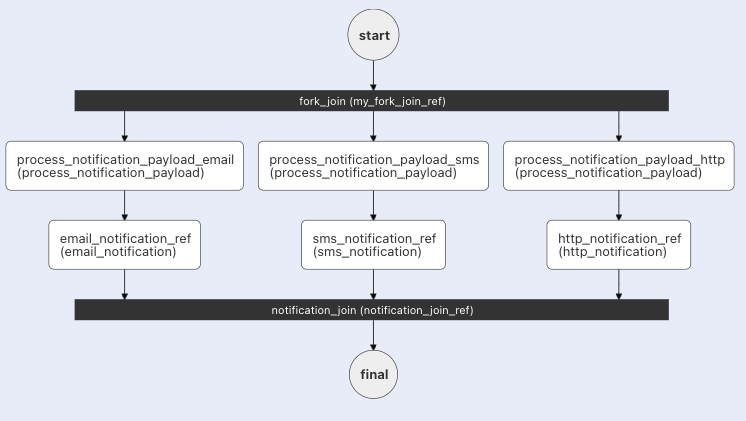Fork
A FORK_JOIN operation lets you run a specified list of tasks or sub workflows in parallel. A FORK_JOIN task is
followed by a JOIN operation that waits on the forked tasks or sub workflows to finish and collects their outputs.
This is also known as a Static Fork to distinguish it from the DYNAMIC_FORK.
Use Cases
FORK_JOIN tasks are typically used when a list of tasks can be run in parallel. E.g In a notification workflow, there
could be multiple ways of sending notifications, i,e e-mail, SMS, HTTP etc. These notifications are not dependent on
each other, and so they can be run in parallel. In such cases, you can create 3 sub-lists of forked tasks for each of
these operations.
Configuration
A FORK_JOIN task has a forkTasks attribute at the top level of the task configuration that is an array of arrays ([[...], [...]]);
| Attribute | Description |
|---|---|
| forkTasks | A list of lists of tasks. Each of the outer list will be invoked in parallel. The inner list can be a graph of other tasks and sub-workflows |
Each element of forkTasks is itself a list of tasks. These sub-lists are invoked in parallel. The tasks defined within each sublist
can be sequential or even more nested forks.
A FORK_JOIN is typically followed by a JOIN operation.
The behavior of a FORK_JOIN task is not affected by inputParameters.
Output
FORK_JOIN has no output.
The FORK_JOIN task is used in conjunction with the JOIN task, which aggregates the output from the parallelized workflows.
Example
Imagine a workflow that sends 3 notifications: email, SMS and HTTP. Since none of these steps are dependant on the others, they can be run in parallel with a fork.
The diagram will appear as:

Here's the JSON definition for the workflow:
[
{
"name": "fork_join",
"taskReferenceName": "my_fork_join_ref",
"type": "FORK_JOIN",
"forkTasks": [
[
{
"name": "process_notification_payload",
"taskReferenceName": "process_notification_payload_email",
"type": "CUSTOM"
},
{
"name": "email_notification",
"taskReferenceName": "email_notification_ref",
"type": "CUSTOM"
}
],
[
{
"name": "process_notification_payload",
"taskReferenceName": "process_notification_payload_sms",
"type": "CUSTOM"
},
{
"name": "sms_notification",
"taskReferenceName": "sms_notification_ref",
"type": "CUSTOM"
}
],
[
{
"name": "process_notification_payload",
"taskReferenceName": "process_notification_payload_http",
"type": "CUSTOM"
},
{
"name": "http_notification",
"taskReferenceName": "http_notification_ref",
"type": "CUSTOM"
}
]
]
},
{
"name": "notification_join",
"taskReferenceName": "notification_join_ref",
"type": "JOIN",
"joinOn": [
"email_notification_ref",
"sms_notification_ref"
]
}
]
Note
There are three parallel 'tines' to this fork, but only two of the outputs are required for the JOIN to continue, owing to the definition of joinOn. The diagram does draw an arrow from http_notification_ref to the notification_join, but it is not required for the workflow to continue.
Here is how the output of notification_join will look like. The output is a map, where the keys are the names of task
references that were being joinOn. The corresponding values are the outputs of those tasks.
{
"email_notification_ref": {
"email_sent_at": "2021-11-06T07:37:17+0000",
"email_sent_to": "test@example.com"
},
"sms_notification_ref": {
"smm_sent_at": "2021-11-06T07:37:17+0129",
"sms_sen": "+1-425-555-0189"
}
}
See JOIN for more details on the JOIN aspect of the FORK.